Puerto Madero Brewery Port, an outdoor option with good beer!
It is a huge space, with outdoor tables that line the Puerto Madero river. A very original proposal, which includes a variety of options for you to enjoy a unique and relaxing moment.
Puerto Madero Brewery Port, an outdoor option with good beer!
It is a huge space, with outdoor tables that line the Puerto Madero river. A very original proposal, which includes a variety of options for you to enjoy a unique and relaxing moment.
What to do in Belgrano, a guide to the best places to visit in one of the largest neighborhoods in the city.
The Belgrano neighborhood is one of the largest and most populated in the city, concentrating some of the busiest and most iconic spots in Buenos Aires. Today the famous Chinatown, the only one of its kind in Argentina, has become popular among porteños, but also and located very close to it are very beautiful and traditional places that mark the history of Belgrano from when it was a town to becoming a neighborhood of Buenos Aires.
Although Belgrano is not one of the neighborhoods that foreign tourists usually visit or those who are in Buenos Aires for the first time for 4 or 5 days, being less popular than Palermo, San Telmo or Recoleta, it constitutes a very pleasant walk for those who visit Buenos Aires through second time, those who want to see the Chinatown or for the same porteños who visit it on weekends.
Paseo de la Infanta, gastronomic pole and open-air center of attraction in the Palermo neighborhood.
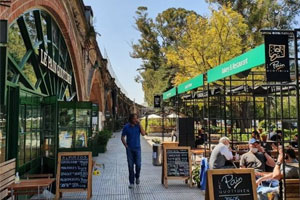 It is located just a few blocks from the renowned Rose Garden, being within the Palermo Parks, between Av. Libertador and Freyre.
It is located just a few blocks from the renowned Rose Garden, being within the Palermo Parks, between Av. Libertador and Freyre.
It is formed as a path of restaurants and bars, breweries and pubs for all styles, tastes and cultures.
It has 36 thousand m2 and is located under the Miter Railroad tracks.
The wealth of this space is to provide a plan for any time of the day, given that it is busy both day and night, and they have running schedules in many of the places that make it up.
 If your walk through the Bosques de Palermo requires a technical stop, this is a great option and you will find a variety of menus and places to sit and enjoy the outdoors without having to go far.
If your walk through the Bosques de Palermo requires a technical stop, this is a great option and you will find a variety of menus and places to sit and enjoy the outdoors without having to go far.
Keep in mind that it is a highly trafficked place, so you will see people circulating throughout the day. From the morning, having breakfast, until late at night.
Given its location, you will find several means of transport that bring you closer to this amazing gastronomy hub. You can get there by Subway, Bus or Train!
Here we leave you a note to see everything you can do in the Palermo neighborhood. In this way, you will be able to put together a plan for a whole day and end it with a nice dinner outdoors.
In turn, here we leave you a note of more places in Buenos Aires to eat outdoors!
Map of Location
What to do in San Telmo, a list with the best options to visit in this beautiful Buenos Aires neighborhood.
The San Telmo neighborhood is the second oldest in the city and despite being the smallest of all, it concentrates much of the spirit of colonial Buenos Aires mixed with a strong culture of diversity, immigration and unique traditions such as its famous Sundays Fair.
The neighborhood can be visited any day during the week is very quiet, with a little more activity closer to the weekend. Without a doubt, the best day to visit it if you want to fully enjoy it is Sunday, when the traditional fair takes place.
A good plan if you are there on Sunday and want to delve deeper into the history of the oldest part of the city, is to join our tour of San Telmo, which begins in the morning in the Jesuit block in Montserrat and enters the heart of San Telmo where you can enjoy its beautiful fair in the afternoon.
Here we are going to tell you everything about what to do in San Telmo:
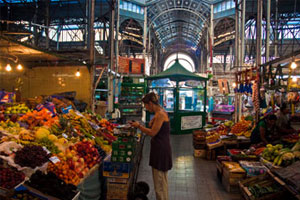 The San Telmo market is one of the few large markets that continue to function of those that existed in all the Buenos Aires neighborhoods at the end of the 19th century. It was built by the architect Buschiazzo in 1897 and served as a large market supplier of fruits, vegetables and food. The building has an iron arched structure that is wonderful. Today the market is a mixture, it still has some stands selling food such as butcher and greengrocers, but some antique dealers have also been established since the neighborhood organized the antiques fair in the 70s and in recent years the market began to evolve into a very rich and varied gastronomic pole with grills, coffees, sandwich shops and all kinds of food on the way and in the bar.
The San Telmo market is one of the few large markets that continue to function of those that existed in all the Buenos Aires neighborhoods at the end of the 19th century. It was built by the architect Buschiazzo in 1897 and served as a large market supplier of fruits, vegetables and food. The building has an iron arched structure that is wonderful. Today the market is a mixture, it still has some stands selling food such as butcher and greengrocers, but some antique dealers have also been established since the neighborhood organized the antiques fair in the 70s and in recent years the market began to evolve into a very rich and varied gastronomic pole with grills, coffees, sandwich shops and all kinds of food on the way and in the bar.
Here we leave you more information!
 The San Telmo Fair takes place every Sunday and originated around the famous Dorrego Square, the second oldest square in the city after Plaza de Mayo. There, surrounded by picturesque colonial and classic buildings and with the towers of the church of San Telmo in sight, antique dealerships are established that since 1970 have sold artistic objects of all kinds. The fair began as an idea by the architect José María Peña as a way to rescue the neighborhood and its traditions and invite everyone to visit the neighborhood on weekends.
The San Telmo Fair takes place every Sunday and originated around the famous Dorrego Square, the second oldest square in the city after Plaza de Mayo. There, surrounded by picturesque colonial and classic buildings and with the towers of the church of San Telmo in sight, antique dealerships are established that since 1970 have sold artistic objects of all kinds. The fair began as an idea by the architect José María Peña as a way to rescue the neighborhood and its traditions and invite everyone to visit the neighborhood on weekends.
More information about Dorrego Square here!
 The San Telmo neighborhood takes its name from Saint Pedro Gonzalez Telmo, protector of sailors. The church that takes its name is located a few meters from Plaza Dorrego and is one of the most beautiful in Buenos Aires. It is a colonial church originally built by Jesuits but which was later clad in the 19th and 20th centuries with a Baroque-Iberian facade. Inside there are several paintings of saints in the Buenos Aires filleting style. Next to the church is the colonial cloister that today is the prison museum.
The San Telmo neighborhood takes its name from Saint Pedro Gonzalez Telmo, protector of sailors. The church that takes its name is located a few meters from Plaza Dorrego and is one of the most beautiful in Buenos Aires. It is a colonial church originally built by Jesuits but which was later clad in the 19th and 20th centuries with a Baroque-Iberian facade. Inside there are several paintings of saints in the Buenos Aires filleting style. Next to the church is the colonial cloister that today is the prison museum.
 On Defense Street, reaching Avenida Independencia, there is an old house built in 1876 for the Ezeiza Family. The house is one of the last aristocratic residences built in the neighborhood during the great move of wealthy families to Recoleta. It is an Italian-style residence with lined courtyards, iron columns and even the old cistern that has been maintained, creating an atmosphere of old Buenos Aires before the great development of French academicism towards the north of the city. Undoubtedly one of the most picturesque places in San Telmo. Today the house is a commercial gallery called The Defense Passage (Pasaje la Defensa) with clothing, handicraft and antique shops.
On Defense Street, reaching Avenida Independencia, there is an old house built in 1876 for the Ezeiza Family. The house is one of the last aristocratic residences built in the neighborhood during the great move of wealthy families to Recoleta. It is an Italian-style residence with lined courtyards, iron columns and even the old cistern that has been maintained, creating an atmosphere of old Buenos Aires before the great development of French academicism towards the north of the city. Undoubtedly one of the most picturesque places in San Telmo. Today the house is a commercial gallery called The Defense Passage (Pasaje la Defensa) with clothing, handicraft and antique shops.
 This gallery is the most “intagram friendly” place in San Telmo. It is a commercial promenade located on the site where the patriot Domingo French lived. The house has kept its old layout of consecutive courtyards with beautiful plants and flowers and covered in colorful umbrellas, a fashion started in Portugal and spread throughout the world, to give a magical touch to the environment.
This gallery is the most “intagram friendly” place in San Telmo. It is a commercial promenade located on the site where the patriot Domingo French lived. The house has kept its old layout of consecutive courtyards with beautiful plants and flowers and covered in colorful umbrellas, a fashion started in Portugal and spread throughout the world, to give a magical touch to the environment.
So, if you don’t know what else to do in San Telmo, a good option is to enter this beautiful house and take lots of photos!
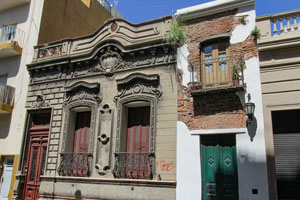 In San Telmo is the narrowest house in Buenos Aires. It is a facade of only 2.5 meters located in the picturesque San Lorenzo Passage and which is popularly known as “the minimal house”. The legend says that a freed slave lived there and the house would be a connection with that old Buenos Aires past where the Afro-descendant population was still a large part of the population of colonial Buenos Aires. The reality is a bit more disappointing: architect José María Peña, who founded the San Telmo fair and was an expert on heritage, concluded that the minimal house is a subdivision into parcels of a larger old property. Likewise, the minimal house continues to enchant all visitors to San Telmo for its curious appearance and the legends that surround it.
In San Telmo is the narrowest house in Buenos Aires. It is a facade of only 2.5 meters located in the picturesque San Lorenzo Passage and which is popularly known as “the minimal house”. The legend says that a freed slave lived there and the house would be a connection with that old Buenos Aires past where the Afro-descendant population was still a large part of the population of colonial Buenos Aires. The reality is a bit more disappointing: architect José María Peña, who founded the San Telmo fair and was an expert on heritage, concluded that the minimal house is a subdivision into parcels of a larger old property. Likewise, the minimal house continues to enchant all visitors to San Telmo for its curious appearance and the legends that surround it.
 In 1985, by accident, a businessman who had invested buying an old house from 1830 for a gastronomic project found archaeological remains of the tubing of the old Tercero del Sur, a stream that crossed San Telmo and emptied into the Río de la Plata. This businessman then decided to change his plans and dedicate himself completely to the archaeological rescue of the ancient tunnels that can be visited today. It is undoubtedly the best archaeological site in Buenos Aires and the only place where tunnels under the city can be seen in a clear and accessible way. The visit is paid and with a guide, so we recommend scheduling it or leaving it for a second visit to the neighborhood or if you live in Buenos Aires. Although it is interesting, for international or foreign tourists who will only spend a day in the neighborhood, it can be ignored.
In 1985, by accident, a businessman who had invested buying an old house from 1830 for a gastronomic project found archaeological remains of the tubing of the old Tercero del Sur, a stream that crossed San Telmo and emptied into the Río de la Plata. This businessman then decided to change his plans and dedicate himself completely to the archaeological rescue of the ancient tunnels that can be visited today. It is undoubtedly the best archaeological site in Buenos Aires and the only place where tunnels under the city can be seen in a clear and accessible way. The visit is paid and with a guide, so we recommend scheduling it or leaving it for a second visit to the neighborhood or if you live in Buenos Aires. Although it is interesting, for international or foreign tourists who will only spend a day in the neighborhood, it can be ignored.
 In San Telmo there is part of the “Paseo de la Historia” (Comic Tour), a series of nice statues that remind us of great people from Argentine comic strips and comics from the 60s and 70s mostly. At the corner of Defensa and Chile is the most famous and beloved character of all: Mafalda, who according to its author Quino lives in the San Telmo Neighborhood. It is common to see tourists from all over the world lining up to get their precious photo with this girl who touches the hearts of all Argentines.
In San Telmo there is part of the “Paseo de la Historia” (Comic Tour), a series of nice statues that remind us of great people from Argentine comic strips and comics from the 60s and 70s mostly. At the corner of Defensa and Chile is the most famous and beloved character of all: Mafalda, who according to its author Quino lives in the San Telmo Neighborhood. It is common to see tourists from all over the world lining up to get their precious photo with this girl who touches the hearts of all Argentines.
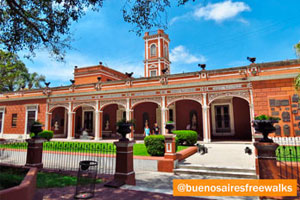 Lezama Park is a traditional park, it was originally the Garden of the House of José Gregorio Lezama and later donated by his widow to the city of Buenos Aires. The park is characterized by its romantic design of winding paths, gazebos, statues, vessels, and an old amphitheater. Also there is the monument to Pedro de Mendoza and on Calle Brasil street the Russian Orthodox church that dazzles with its Moscow style. On Defense Street, the old Lezama mansion in a picturesque Italian style remains, which today is the National Historical Museum, a must for those interested in Argentine history.
Lezama Park is a traditional park, it was originally the Garden of the House of José Gregorio Lezama and later donated by his widow to the city of Buenos Aires. The park is characterized by its romantic design of winding paths, gazebos, statues, vessels, and an old amphitheater. Also there is the monument to Pedro de Mendoza and on Calle Brasil street the Russian Orthodox church that dazzles with its Moscow style. On Defense Street, the old Lezama mansion in a picturesque Italian style remains, which today is the National Historical Museum, a must for those interested in Argentine history.
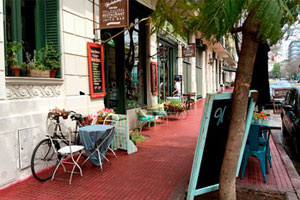 Caseros Avenue separates the San Telmo neighborhood from Barracas and is where some of the most beautiful buildings in the area were built. There the houses were built for the British workers of the Southern Railway called “tenement of the English” in a beautiful building that transports us to a classic European boulevard. Continuing uphill we also find several very beautiful buildings. Today the avenue has become a gastronomic pole with an interesting offer of bars and restaurants.
Caseros Avenue separates the San Telmo neighborhood from Barracas and is where some of the most beautiful buildings in the area were built. There the houses were built for the British workers of the Southern Railway called “tenement of the English” in a beautiful building that transports us to a classic European boulevard. Continuing uphill we also find several very beautiful buildings. Today the avenue has become a gastronomic pole with an interesting offer of bars and restaurants.
We invite you to join our San Telmo Tour here!
Floralis Generic, an imposing sculpture in the Palermo neighborhood.
It is a metal sculpture 20m high, which is located in the United Nations Square.
Donation made by its author, the Argentine architect Eduardo Catalano.
Lezama Square (Parque Lezama), the most luxurious green space in the city of Buenos Aires.
It is a traditional walk in the City of Buenos Aires. Located in the San Telmo neighborhood, on the border with La Boca and Barracas, between Defensa, Brasil, Av. Paseo Colón and Av. Martín García streets.
San Martín Plaza, one of the oldest in the city of Buenos Aires, in the heart of Retiro.
It is one of the few green spaces where several historical events took place.
In 1807, a combat was carried out, which ended in victory. In 1812, San Martín installed the barracks of the Horse Grenadier Regiment, so in 1878, before the centenary of his birth, he was commemorated by giving his name to this beautiful and enormous space. In 1942 it was declared a Historic Place of the city.
Botanical Garden, an immense space, full of nature, in the heart of Palermo.
If you like plants, trees and vegetables, this place is special for you!
 With more than 7 hectares, it is the center of 6,000 plant species. As you walk through the Garden, each species has its name so that you can learn about each of the varieties found there.
With more than 7 hectares, it is the center of 6,000 plant species. As you walk through the Garden, each species has its name so that you can learn about each of the varieties found there.
Located on Av. Santa Fe and República Árabe Syria, it is an immense space of pure air, ideal for a day of walking, relaxation and learning.
It has 5 greenhouses, a botanical library, three gardens with French, Oriental and Roman styles, a herbarium and, many times, you will be able to find art samples in its beautiful English-style house.
Entrance is free and open.
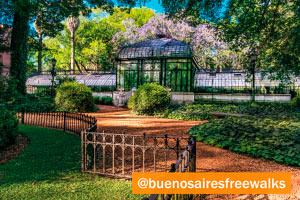 We provide you with the garden hours so that you can plan your visit to the place well. On Mondays it is closed for cleaning and specific care. In summer (September 22 to April 21) it opens Tuesday to Friday from 8 a.m. to 6:45 p.m. and Saturday, Sunday and holidays from 9:30 a.m. to 6:45 p.m. In winter (April 22 to September 21) Tuesday to Friday open from 8 a.m. to 5:45 p.m. and Saturday, Sunday and holidays from 9:30 a.m. to 5:45 p.m.
We provide you with the garden hours so that you can plan your visit to the place well. On Mondays it is closed for cleaning and specific care. In summer (September 22 to April 21) it opens Tuesday to Friday from 8 a.m. to 6:45 p.m. and Saturday, Sunday and holidays from 9:30 a.m. to 6:45 p.m. In winter (April 22 to September 21) Tuesday to Friday open from 8 a.m. to 5:45 p.m. and Saturday, Sunday and holidays from 9:30 a.m. to 5:45 p.m.
Here we leave their website so you can have the updated information.
And, on this other note, we leave you all the available options to enjoy Buenos Aires outdoors!
We provide you with its location so you can see how to get there. Many means of transport reach this area, since it is one of the largest neighborhoods in Buenos Aires.
Japanese Garden, with elements of its own culture, is the only green space with distinctly Japanese characteristics. It is a corner that falls in love with everyone who visits it.
It was built in 1967, as a testimony to the visit of the Emperor of Japan, Akihito.
 Located in the heart of Palermo, very close to the Bosques de Palermo, it is a space of harmony that cuts through the bustle of the city. It is like entering a world of Japanese fantasy. Without a doubt, we believe that you are going to fall in love with this wonder, so we recommend you go early and early. In this way, you will not be in a hurry and you can walk calmly throughout its interior.
Located in the heart of Palermo, very close to the Bosques de Palermo, it is a space of harmony that cuts through the bustle of the city. It is like entering a world of Japanese fantasy. Without a doubt, we believe that you are going to fall in love with this wonder, so we recommend you go early and early. In this way, you will not be in a hurry and you can walk calmly throughout its interior.
Its trees are charming, and the entire structure of the garden is ornamented with traditional elements from Japan. It has native trees such as Tipa and Palo Borracho, and also a great variety of typical Japanese plants such as sakura and azaleas.
Another note of color is that in the lagoon you will find the typical Koi fish and carp of various colors.
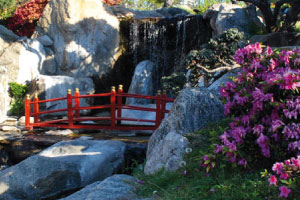 All its elements seek balance and harmony. The bridges inside are symbols, such as the Bridge of God, curved and representing the way to paradise; the Truncated Bridge, which leads to the island of miraculous remedies, and the Bridge of decisions or Zig Zag Bridge.
All its elements seek balance and harmony. The bridges inside are symbols, such as the Bridge of God, curved and representing the way to paradise; the Truncated Bridge, which leads to the island of miraculous remedies, and the Bridge of decisions or Zig Zag Bridge.
In addition to its garden, it has a building that is a center for Japanese cultural activities for everyone who likes it. Also, it has an exhibition about their culture, with kimonos, paintings, origami and more. It has a typical Japanese restaurant to enjoy this delicious food, and a nursery to buy various plants and food for Koi fish, since it is forbidden to throw food at them that is not suitable. For those of us who like to have souvenirs, rest assured that there is a store with a variety of Japanese items where you will want to buy everything! It also has a Chashitsu (tea house), it is a space specially built to experience the traditional Japanese tea ceremony.
Here we leave you their website so that you can purchase the tickets.
The city of Buenos Aires has many attractions, activities and must-see places like this one. In this note, we tell you about several different plans to enjoy a day outdoors in this wonderful city!
Carlos Thays Park, in the heart of Recoleta and very close to many other activities, which we tell you in this other note to enjoy Buenos Aires outdoors!
This large park has 4500m2 (more than 4 hectares), and bears this name in honor of the well-known Landscape Architect Carlos Thays.
 A characteristic that distinguishes it and differentiates it from the other parks is that it is one of the few that has a great variety of sculptures. Here, you will find outstanding works by great and well-known artists such as Marta Minujín (“United Nations“); the plastic artist Fernando Botero (“Male Torso“); the Italian sculptor Alejo Afani (“Pro National Culture“); among many others.
A characteristic that distinguishes it and differentiates it from the other parks is that it is one of the few that has a great variety of sculptures. Here, you will find outstanding works by great and well-known artists such as Marta Minujín (“United Nations“); the plastic artist Fernando Botero (“Male Torso“); the Italian sculptor Alejo Afani (“Pro National Culture“); among many others.
Entrance is free and open!
Located on Av. Figueroa Alcorta and Av. Callao, it is very close to some bars to enjoy a picnic in the open air and, later, to be able to go for a drink in the same area. Also, it is a few steps from the Law School, the National Museum of Fine Arts, the Floralis Genérica and the Recoleta Cemetery.
It is truly a beautiful green space to enjoy a bit of the outdoors, close to many other attractions so you can plan a whole day in Recoleta. For more information, read this other note about this magnificent and picturesque neighborhood of Buenos Aires.
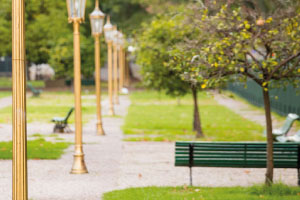 What we do ask you is that, if you consume something in the park, then take your garbage to the nearest bin, to preserve the place. Preserving green spaces is everyone’s job!
What we do ask you is that, if you consume something in the park, then take your garbage to the nearest bin, to preserve the place. Preserving green spaces is everyone’s job!
-Don’t let his name confuse you! There are other spaces that bear the name of this renowned landscaper, such as the Botanical Garden.
-Here we leave you the map so you can see where it is and everything that you have nearby!